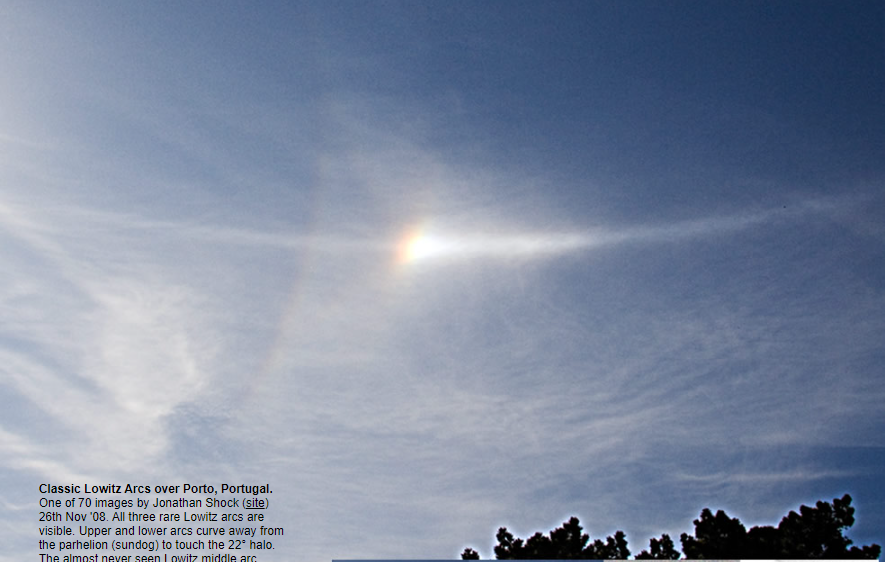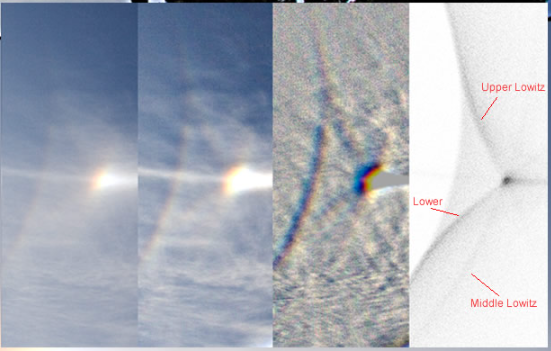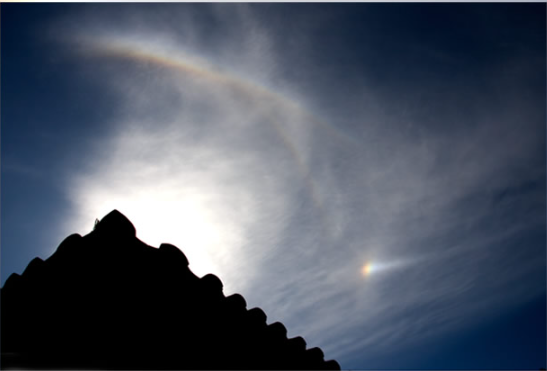Lowitz Arcs - Portugal
Lowitz Arcs - Portugal: A Rare Atmospheric Phenomenon
Lowitz arcs, a rare atmospheric optical phenomenon, were first recorded in 1790 over St Petersburg. However, their existence was long doubted until comparatively recent photographs confirmed their presence. These arcs are formed from ice crystals in the atmosphere, but the exact process remains controversial and subject to ongoing research.
The Traditional Model and Formation of Lowitz Arcs
According to the traditional model, Lowitz arcs are formed by regular and thin hexagonal plate crystals. These crystals take all rotational positions about a horizontal axis passing through opposite prism edges. As a result, three arcs are produced: an upper arc, a middle arc, and a lower arc. However, while this model predicts the positions of the arcs, it often fails to accurately predict their extent or relative intensities.
Jonathan Shock's Observations in Porto, Portugal
In Porto, Portugal, Jonathan Shock captured a series of stunning images of Lowitz arcs over a span of 22 minutes. His photographs revealed the gradual development of these rare atmospheric phenomena. Initially, an upper Lowitz arc appeared at the 2 o'clock position from the sun, located above but not near the sundog. Additionally, there was a faint upper tangent arc, a hint of a Parry arc, a bright parhelic circle, and a very bright 120° parhelion. Interestingly, the 22° halo was likely absent during this particular display.
The Development of Lowitz Arcs
As the observation continued, a downward-sloping middle arc began to emerge from the sundog. This development is particularly noteworthy since upper and lower Lowitz arcs near the parhelion were still not apparent at this stage. However, as the display progressed, all three arcs eventually developed near the parhelion, resulting in a mesmerizing spectacle captured in one of Shock's final images.
Crystal Simulations and Crystal Shapes
To better understand the formation of Lowitz arcs, simulations were conducted using a combination of traditionally oriented crystals and regular hexagonal plates with limited rotation about the Lowitz axis. The results indicated that rather thick plates were required to accurately replicate the observed near parhelion arcs. However, it is worth noting that a better fit might have been achieved by incorporating non-regular hexagonal plates, which could emphasize the middle arc without producing excessive intensity in the upper and lower arcs near the parhelion.
The Sensitivity of Lowitz Arcs to Crystal Shapes and Orientations
One intriguing aspect of Lowitz arcs is their sensitivity to crystal shapes and their specific orientations. Unlike a tangent arc, which appears similar regardless of the variety of hexagonal crystal shapes and lengths that form it, Lowitz arcs exhibit distinct variations. This sensitivity adds complexity to understanding these atmospheric phenomena and highlights the need for further research in crystal shapes and orientations to better explain the formation of Lowitz displays.
The Legacy of Professor Lowitz
Professor Lowitz, after whom these arcs are named, initiated the study of these atmospheric phenomena over two hundred years ago. His work laid the foundation for ongoing research and continues to inspire scientists to unravel the mysteries surrounding Lowitz arcs.
In conclusion, the observation of Lowitz arcs in Porto, Portugal provides valuable insights into these rare atmospheric phenomena. While the traditional model offers some understanding of their formation, there is still much to learn about the specific crystal shapes and orientations that give rise to these captivating displays. The sensitivity of Lowitz arcs to these factors adds an additional layer of complexity, underscoring the need for continued research in this fascinating field of atmospheric optics.

Classic Lowitz Arcs over Porto, Portugal. One of 70 images by Jonathan Shock (site) 26th Nov '08. All three rare Lowitz arcs are visible. Upper and lower arcs curve away from the parhelion (sundog) to touch the 22° halo. The almost never seen Lowitz middle arc slopes downward through the sundog. Images ©Jonathan Shock, shown with permission.

Lowitz arcs were first recorded in 1790 over St Petersburg but their existence was long doubted until photographs were obtained comparatively recently. The way they are formed from ice crystals still remains controversial.
The traditional model assumes regular and thin hexagonal plate crystals taking all rotational positions about a horizontal axis passing through opposite prism edges and producing three arcs - see diagram below. It predicts the arc positions but rarely their extent or relative intensities.
Jonathan Shock took photographs over 22 minutes. Initially there was an upper Lowitz arc at the 2 o'clock position from the sun and above it but not near the sundog. There was a weak upper tangent arc, a hint of a Parry arc, a bright parhelic circle and very bright 120° parhelion. The 22° halo was probably absent. Later on, a suspicion of a Lowitz middle arc projected downward from the sundog - see the lower image at right. Upper and lower Lowitz arcs near the parhelion were still not apparent. The top image is one of the final ones taken when all three arcs had developed near the parhelion. As in many displays, cloud streaks can be mistaken for Lowitz arcs, Jonathan's many images helped avoid that.
The montage shows successive enhancements of the near parhelion arcs. The HaloSim simulation used a mix of traditionally oriented crystals and regular hexagonal plates with limited rotation about the Lowitz axis. Rather thick plates were needed.
The same crystals simulated the lower image taken earlier in the display. A better fit might have resulted from non-regular hexagonal plates to emphasise the middle arc without producing so much intensity in the upper and lower arcs near the parhelion.
There is unease about having to invoke such special requirements. Attractive explanations are ones that predict reality with minimum assumptions. Do we have the explanation for Lowitz displays wrong? Not impossible. But there is another factor, the appearance of Lowitz arcs is much more sensitive to crystal shapes and their particular orientations than most other halos. A tangent arc looks much the same regardless of the variety of hexagonal crystal shapes and lengths that make it - Lowitz arcs do not. Professor Lowitz certainly started something over two hundred years ago.


Note: this article has been automatically converted from the old site and may not appear as intended. You can find the original article here.
Reference Atmospheric Optics
If you use any of the definitions, information, or data presented on Atmospheric Optics, please copy the link or reference below to properly credit us as the reference source. Thank you!
-
<a href="https://atoptics.co.uk/blog/lowitz-arcs-portugal/">Lowitz Arcs - Portugal</a>
-
"Lowitz Arcs - Portugal". Atmospheric Optics. Accessed on December 22, 2024. https://atoptics.co.uk/blog/lowitz-arcs-portugal/.
-
"Lowitz Arcs - Portugal". Atmospheric Optics, https://atoptics.co.uk/blog/lowitz-arcs-portugal/. Accessed 22 December, 2024
-
Lowitz Arcs - Portugal. Atmospheric Optics. Retrieved from https://atoptics.co.uk/blog/lowitz-arcs-portugal/.